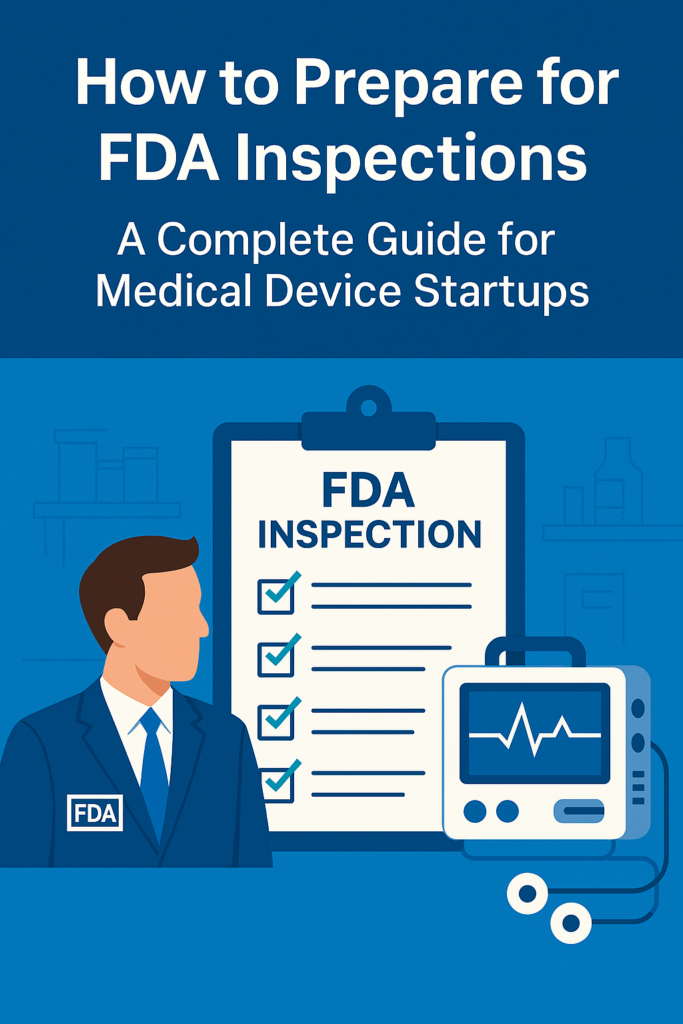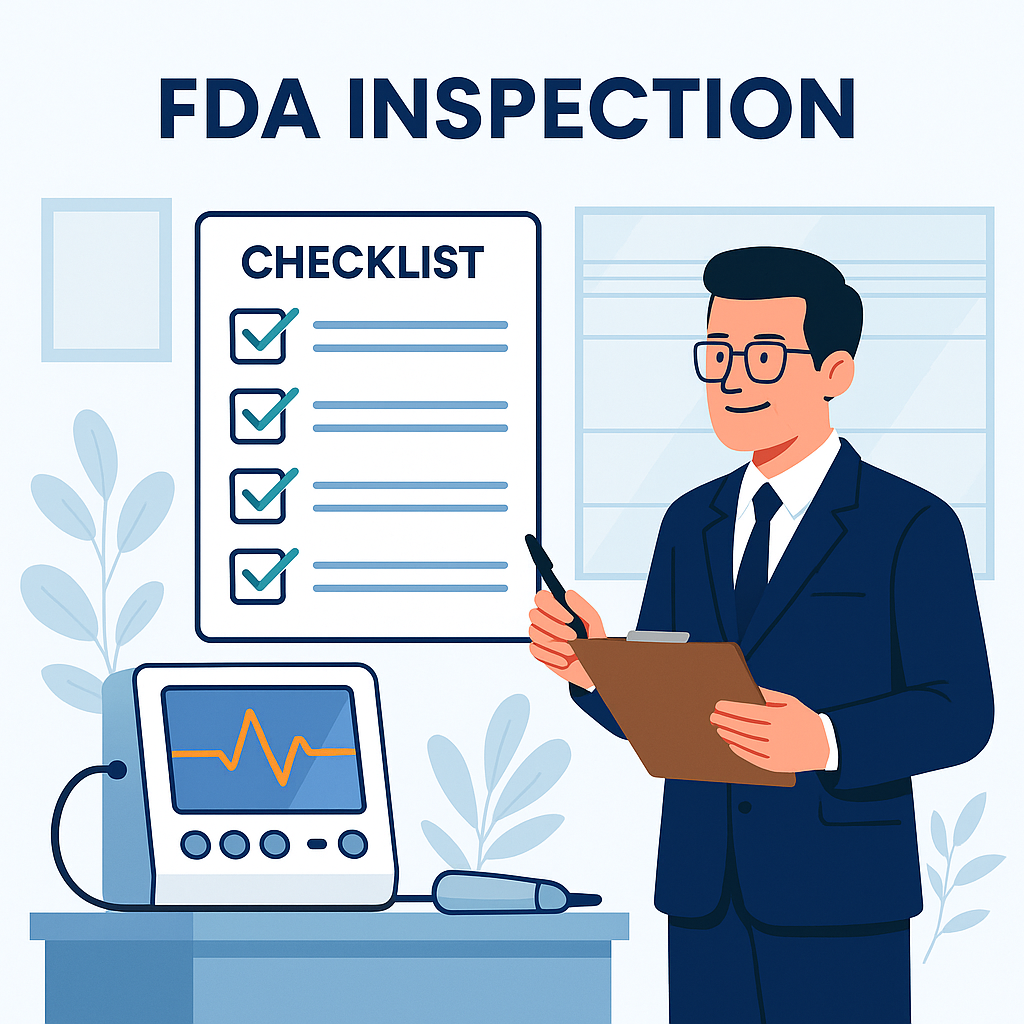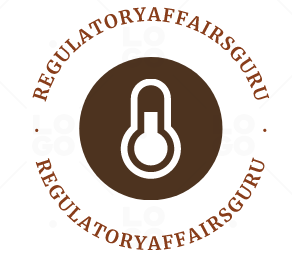???? Introduction: Why FDA Inspections Matter

FDA inspections are not random or punitive; they ensure that medical devices distributed in the U.S. market are safe and effective.
For scaling MedTech startups and companies, an FDA inspection can:
✅ Verify your Quality Management System (QMS) readiness.
✅ Enhance investor and partner confidence.
✅ Serve as a test lab before scaled manufacture.
✅ Avoid costly consequences of non-compliance.
Conversely, not auditing can lead to the following:
❌ FDA Form 483 Observations (made public, reputational harm).
❌ Warning Letters (made public, reputational harm).
❌ Import detention and sales suspension.
Seizures of goods can lead to litigation.
Preparation beforehand saves your staff time, sets your QMS in motion, and makes you treat inspections as a formality and not an emergency.
???? What Triggers FDA Inspections?
FDA inspections are performed by:
✅ Periodic Routine Surveillance Inspections: Under the Establishment Inspection Program (EIP), they are performed periodically and regularly for U.S. exporters of devices.
✅ Pre-Approval Inspections (PAI): If you submit a PMA, the FDA will inspect your facility to ensure that you can produce your device to approved standards consistently before approval is granted.
✅ For-Cause Inspections: Triggered by:
Customer complaints and adverse event reports, known as Medical Device Reports (MDRs), are received.
A whistleblower or competitor may lodge a complaint.
Recalls or field actions have also been received.
Significant revisions to the process or leadership are required.
Foreign Manufacturer Inspections: Foreign manufacturers exporting devices to the United States.
Verification of corrective action following a warning letter or 483 is done through follow-up inspections.
Takeaway: FDA inspections are not random but rather structured, and preparation is crucial for market entry.
???? Types of FDA Inspections
FDA inspections vary by purpose and size:
✅Level 1 (Abbreviated Inspections):
Usually, it’s used for routine monitoring.
Addresses four key subsystems:
Corrective and Preventive Actions (CAPA).
Complaints and Medical Device Reporting (MDR).
Production and Process Controls.
Design Controls (for Class II/III devices).
It lasts 2–4 days, depending on complexity.
✅ Level 2 (Comprehensive Inspections):
A more detailed review of all QMS subsystems.
This applies to cases involving new manufacturers or “for-cause” situations.
The process usually takes 4-7 days.
✅ Pre-Approval Inspections (PAI):
Pre-Approval Inspections (PAI) are exclusively reserved for PMA applicants.
Verifies your preparedness to manufacture devices based on submission claims.
The process guarantees that the test data you’ve submitted aligns with your production capacity.
FDA inspections use the Quality System Inspection Technique (QSIT) to achieve systematic, standard evaluation.

????️ Step-by-Step: Preparing for FDA Inspections
1️⃣ Establish and Sustain a Strong QMS
Your 21 CFR Part 820 (QSR)-based Quality Management System (QMS) is the FDA’s highest inspection priority.
Ensure you possess:
✅ Document Control:
You should possess approved, controlled, and current Standard Operating Procedures (SOPs), policies, and work instructions.
The documents are version-controlled, accessible, and retrievable.
✅ Design Controls:
A recent Design History File (DHF) with
User inputs, design outputs, and requirements are included in the design controls.
The file also includes verification and validation reports.
The process involves conducting design reviews and making necessary changes.
Traceability matrices.
✅ CAPA System:
The CAPA System involves the systematic identification, documentation, investigation, and correction of nonconformances through a series of steps.
Effectiveness checks to ensure issues are closed.
✅ Complaint Handling:
Maintain a complaint log and conduct a prompt investigation.
We implement MDR reporting procedures to address adverse events.
✅ Supplier Management:
The Approved Supplier List (ASL) includes evaluation, selection, and monitoring records.
Supplier quality agreements where relevant.
✅ Production and Process Controls:
Critical processes such as sterilization and bonding require process validations.
We maintain the Device Master Record (DMR) and Device History Records (DHR) to guarantee traceability.
✅ Equipment Maintenance and Calibration:
Documents detailing the calibration of measurement devices are essential.
Maintain records to show operational preparedness.
A well-organized, current QMS reduces inspection risks by far.
2️⃣ Appoint an Inspection Readiness Team
Recruit and train:
✅ Inspection Lead (RA/QA Manager):
The Inspection Lead serves as the initial point of contact for the FDA inspector.
The role also involves ensuring consistent communication with the FDA inspector.
✅ Scribe:
Manages inspector requests, questions, and company replies.
The Scribe is responsible for maintaining records of issued documents and engaging in discussions on various topics.
✅ SMEs (Subject Matter Experts):
SMEs (Subject Matter Experts) are prepared to respond to inquiries related to design controls, complaints, production, or CAPA topics.
✅ Runner:
The runner promptly retrieves the requested documents and records.
This is important because it helps the organization avoid panic, provide accurate answers, and prevent delays during the inspection.
3️⃣ Conduct Internal Mock FDA Inspections
✅ Conduct a mock FDA inspection with your internal RA/QA personnel or outside experts.
✅ Apply QSIT methodology to incorporate:
CAPA.
Complaints.
Production controls.
Design controls.
Supplier controls.
✅ Test:
The speed at which documents are retrieved is a crucial factor.
The staff is prepared to provide responses.
Walk through compliance with the facility.
✅ Identify and rectify gaps before inspection, reducing your risk of 483 observations.
4️⃣ Facility Readiness for Inspection
✅ Inspection Room:
Quiet, clean, with power and room for the inspector.
If necessary, the room is equipped with a printer and Wi-Fi.
✅ Document Access:
Keep a tidy index of:
Quality Manual.
Master Document List.
SOPs and forms are also available.
We maintain CAPA and complaint logs.
Training records.
✅ Cleanliness of the Facility:
Ensure the production area is clean, labeled, and unapproved practice-free.
The equipment should be calibrated and clearly labeled.
✅ Labeling and Storage:
The process involves the separation of raw materials, in-process materials, and finished products.
The area that controls sensitive products is under strict control.
5️⃣ Train All Employees on FDA Inspection Conduct
✅ Train all employees in:
When receiving FDA inspectors, employees should refer them to the RA/QA lead.
Maintaining open communication with inspectors is crucial.
Acceptable answers:
Answering questions directly and honestly, no guessing.
Acceptable answers include: “Yes,” “No,” or “I don’t know; let me check.”
“I will get the correct document/person for you.”
✅ Encourage a culture of openness, respect, and peacefulness during inspections.
What Does an FDA Inspection Involve?
1️⃣ Arrival: The inspector introduces themself and hands over FDA Form 482 (Notice of Inspection).
2️⃣ Opening Meeting: The inspector outlines the inspection’s scope and purpose.
3️⃣ Facility Tour: The inspector tours the production, laboratories, and warehouses.
4️⃣ Document Reviews: The inspector reviews the SOPs, documents, and quality records per QSIT.
5️⃣ Interviews: Regarding processes, design controls, and complaints, SMEs may be questioned.
6️⃣ Daily Wrap-Ups: The Inspector can recap findings, enumerating minor issues.
7️⃣ Close-Out Meeting: The inspector signs an FDA Form 483 where findings are present, and every point is enumerated.
Pro Tip: Utilize close-out meetings to clarify any misunderstandings and challenge observations.
???? Managing FDA Form 483 Observations
If you have an FDA Form 483:
✅ Read and review each observation carefully.
If necessary, clarify and sort issues immediately.
✅ Corrective action will be taken promptly.
✅ A written response will be provided within 15 business days, which will include:
The written response included an acknowledgement of the observation.
Corrective actions were immediately taken.
Preventive actions for the future.
Implementation timelines.
A timely, professional, and precise response can avoid issuing a warning letter.
???? FDA Inspection Success Best Practices
✅ Be Prepared: Keep a QMS inspection ready at all times.
✅ Be organized: Keep clean, up-to-date, and accessible documents.
✅ Communicate Effectively: Use your inspection team organization to facilitate easy communication.
✅ Remain Calm and Professional: Inspections are standard procedures and not personal.
✅ Be Transparent: Never hide, simulate, or deny findings.
✅ Correct Immediately: Use inspection findings to enhance your systems.
???? Post-Inspection Actions
✅ Implement corrective and preventive actions for findings.
✅ Amend SOPs and training, if necessary.
✅ Internalize lessons learned to prevent recurrence.
✅ Receive FDA status updates as necessary.
✅ Use the inspection as a chance to continuously improve your QMS.
???? Real-World Example
The FDA conducted its first inspection of a Class II medical device startup during its scaling phase.
✅ The startup had a documented Quality Management System (QMS) that included a complete Design History File (DHF) and training records.
✅ Identify an inspection team, conduct a retrieval drill, and conduct the mock audit.
✅ The FDA conducted a 4-day Level 2 inspection but did not issue a Form 483.
The successful inspection:
✅ Improved investor confidence.
✅ Enabled partnership distribution agreements.
✅ Prevented remediation delay costs.
???? Why FDA Inspection Readiness is so Important
✅ Ensures regulatory compliance and easy access to markets.
✅ Establishes new investor, partner, and customer confidence.
✅ Qualifies your internal processes, reducing quality concerns.
✅ Employs post-market scaling with confidence.
✅ Prevents cost-disrupting warning letters and recalls.
FDA inspection preparedness is at the heart of creating a successful, compliant, scalable MedTech firm.
References
FDA, Inspection of Medical Device Manufacturers
https://www.fda.gov/medical-devices/overview-device-regulation/inspection-medical-device-manufacturers
FDA, Quality System Inspection Technique (QSIT) Guide
https://www.fda.gov/media/79736/download
FDA, Form FDA 483: Frequently Asked Questions
https://www.fda.gov/inspections-compliance-enforcement-and-criminal-investigations/inspection-references/form-fda-483-frequently-asked-questions
21 CFR Part 820 — Quality System Regulation
https://www.ecfr.gov/current/title-21/chapter-I/subchapter-H/part-820
📢 Next on Your Blog:
“Complaint Handling and CAPA: Building Effective Systems for FDA Compliance.”
✅ Learn how to implement robust complaint and CAPA systems.
✅ Avoid recurring issues and strengthen quality.
✅ Ensure your QMS aligns with FDA inspection priorities.
